
Equipment for Seniors
Product Guides and Recommendations
There are literally hundreds of types of equipment for seniors that claim to make life safer and easier. But how do you decide what your aging parents need and what works best?
That's why we wrote this guide. It will help you sort through all the mess.
As health care professionals, part of our job is to educate families and their aging parents on products that make their lives safer and easier.
Over the years, we've met families that have purchased equipment for their loved ones that does't get used because it's the right idea but the wrong product.
Did you know that a commode can be used at the bedside and over the toilet? And that it can replace both a raised toilet seat and a toilet safety frame?
Are you wondering if you should purchase a bath bench or a bath chair? Or maybe a bath lift?
Read more about equipment for seniors to find products that can help your elderly parents.
Table of Contents
Jump to sections:
Bathroom Products |
Mobility Products |
Bedroom Products |
Dressing Products |
Communication Products |
Bathroom Products
Elevated Toilet Seats
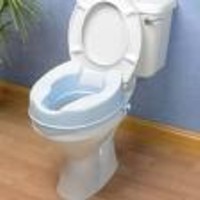
Description:
Removable devices that raise the toilet seat height by 3-4 inches.
Who should use this equipment for seniors:
Individuals who have difficulty bending or sitting on low surfaces.
For more information: Elevated Toilet Seats
Toilet Safety Rails
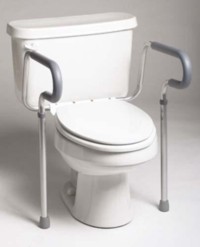
Description:
Securely attaches to the toilet to provide stability and security while sitting down and standing up.
Who should use this equipment for seniors:
Individuals who need additional support to sit and stand.
For more information: Toilet Safety Rails
Commode Seats
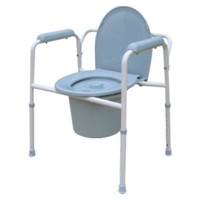
Description:
Can be placed by the individual's bedside so they do not have to walk very far to go to the bathroom.
Who should use this equipment for seniors:
Individuals who are at risk for falls or have a difficult time traveling to the bathroom because of the location of the bathroom.
For more information: Commode Seats
Shower Bench
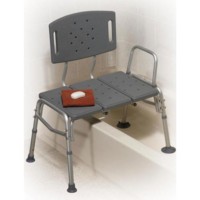
Description:
Benches that extend beyond the edge of the bathtub which makes it easier to transfer in and out.
Who should use this equipment for seniors:
Individuals with mobility difficulties. For example, those who use crutches, a walker, or a wheelchair. Transfer benches will help them safely transfer in and out of the tub without being at risk for slipping and falling.
For more information: Shower Bench
Bathtub Chair
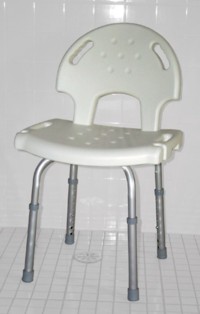
Description:
A chair that provides a comfortable seating surface for bathing or showering.
Who should use this equipment for seniors:
Individuals who have low endurance, or difficulty standing in the shower or tub.
For more information: Bathtub Chair
Bathtub Lifts
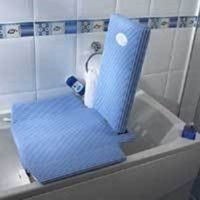
Description:
Raises and lowers the user into the bathtub. Powered by battery or water power.
Who should use this equipment for seniors:
Individuals who enjoy taking a bath yet are at risk for falling or slipping due to decreased endurance or poor balance.
For more information: Bathtub Lifts
Bath Rail
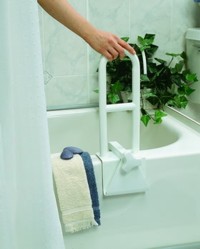
Description:
A grab bar that attaches to the side of the tub, which helps provide additional support while moving in and out of the tub.
Who should use this equipment for seniors:
Individuals who have difficulty moving in and out of the tub and need additional support to prevent slipping and falling.
Bathroom Grab Bars
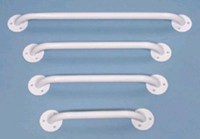
Description:
Grab bars come in a variety of shapes/sizes and can be placed by the shower, toilet and other locations.
Who should use this equipment for seniors:
Individuals who need extra support moving in and out of the shower, on and off the toilet and many other places.
For more information: Bathroom Grab Bars
Hand Held Shower Head

Description:
Allows the user to move the shower head.
Who should use this equipment for seniors:
Individuals who use a shower chair or transfer bench as they can shower more easily with this device.
For more information: Hand Held Shower Head
Long Handled Sponge
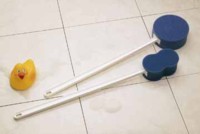
Description:
They come in a variety of lengths and have a long handle with a sponge at the end.
Who should use this equipment for seniors:
Individuals with limited joint movement can benefit from the long length and bendable features which make it an ideal bathing sponge.
Bedroom Products
Bed Rail
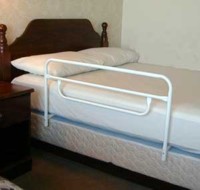
Description:
Securely attaches to the bed to provide assistance to individuals who have difficulty getting in and out of bed.
Who should use it:
Individuals who need additional support to get in and out of bed.
More information on: Bed Rails for Elderly
Bed Risers
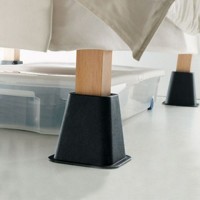
Description:
Raises the bed height from 2-6 inches. Comes in a variety of shapes and sizes.
Who should use it:
Individuals who have difficulty getting up and down from lower surfaces.
Blanket Support
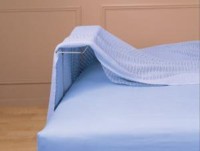
Description:
Lifts up the blankets and sheets so that they do not touch the users feet.
Who should use it:
Individuals recovering from injury or surgery, suffering from bunions and ingrown toenails, joint pain and arthritis, and other foot and leg problems.
Bed Wedge
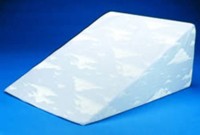
Description:
Designed to elevate the upper body or legs, or to use as a trunk stabilizer when side-lying.
Who should use it:
Individuals with problem breathing, poor circulation, hiatus hernia, back or neck problems.
Mobility Products
Light Weight Wheelchair

Description:
A self-propelled wheelchair that comes in a variety of shapes, sizes and colors.
Who should use it:
Individuals who have difficulty walking due to endurance, balance or neurological issues.
More information on: Light Weight Wheelchair
Transport Wheelchair
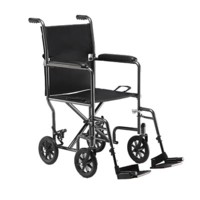
Description:
Similar to a manual wheelchair although is not designed to be self-propelled. The individual using the wheelchair is often pushed by another person. It is easier to transport in a vehicle as they are lighter, have smaller wheels and are more compact when folded.
Who should use it:
Individuals that need a wheelchair for longer distances and have someone that can assist them (by pushing the chair).
More information on: Transport Wheelchair
Shower Wheelchair
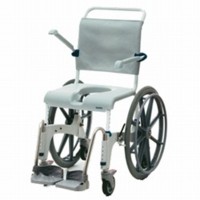
Description:
A wheelchair that is designed to get wet so that it can be used in the shower.
Who should use it:
Individuals who use a wheelchair and have a roll-in shower. Can be self-propelled or pushed by a caregiver.
More information on: Shower Wheelchair
Motorized Wheelchair
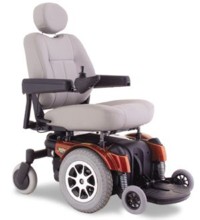
Description:
A wheelchair that is powered by an electric motor. Come in a variety of shapes, sizes and features.
Who should use it:
Individuals who have difficulty walking and are not suitable for manual wheelchair due to decreased endurance or neurological issues.
More information on: Motorized Wheelchair
Scooters for Elderly
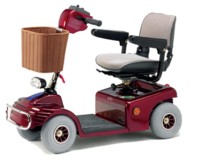
Description:
Scooters for elderly a mainly designed for traveling outside of the home.
Who should use it:
Individuals who have difficulty walking longer distances. Can be good alternatives to driving or public transportation for short trips.
More information on: Scooters for Elderly
Rollator Walker
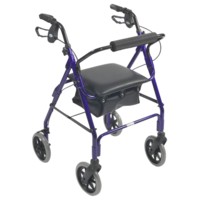
Description:
A walker with four wheels, brakes and usually a basket. Comes in a variety of shapes, sizes and features.
Who should use it:
Individuals who have balance or endurance difficulties and are at risk for falls.
More information on: Rollator Walker
Front Wheel Walker
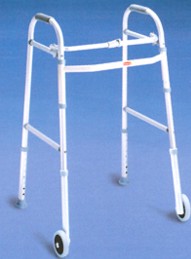
Description:
A walker with wheels on the two front legs. Come in a variety of shapes, sizes and features.
Who should use it:
Individuals who have balance or endurance difficulties and are at risk for falls.
More information on: Front Wheel Walker
Folding Walker
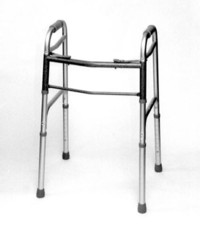
Description:
A walker without wheels. Comes in a variety of shapes and sizes.
Who should use it:
Individuals who have balance or endurance difficulties and are at risk for falls.
More information on: Folding Walker
Folding Cane
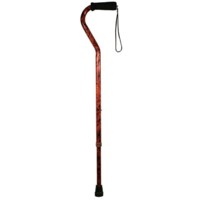
Description:
A single point walking cane. Comes in a variety of shapes and sizes.
Who should use it:
Individuals who have slight balance or endurance difficulties.
More information on: Folding Cane
Communication Products
Cell Phones for Elderly
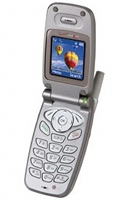
Description:
A cell phone designed for elderly with larger buttons and user friendly features.
Who should use it:
Individuals who could benefit from a phone that has larger buttons and easy to use features.
More information on: Cell Phones for Elderly
Phones for Elderly
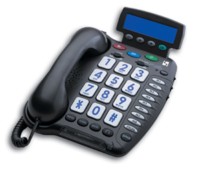
Description:
Phones designed for elderly. Larger buttons and amplified volume options.
Who should use it:
Seniors that have difficulty hearing.
More information on: Phones for Elderly
Elderly Medical Alert
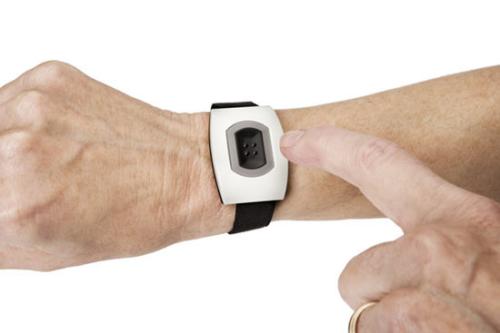
Description:
An emergency system that a senior wears as a bracelet or necklace that they can push to signal for help.
Who should use it:
Seniors who are at risk for falls, especially those that live alone.
More information on: Elderly Medical Alert
Dressing Products
Long Shoe Horn
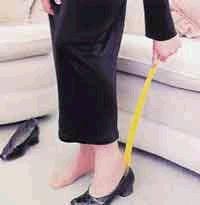
Description:
Just as the names suggests... a long handled shoe horn.
Who should use it:
Individuals who have difficulty reaching and bending down to put their shoes on.
Elastic Laces
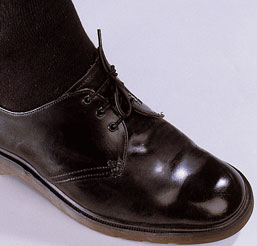
Description:
Elastic laces that tie like regular laces but enable the user to slip into the shoe.
Who should use it:
Individuals who have difficulty bending and reaching to tie their shoe laces.
Sock Aid
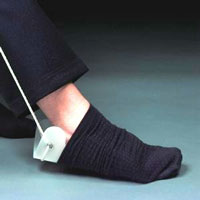
Description:
Device that allows users to pull socks on without reaching or bending down to their feet.
Who should use it:
Individuals who have difficulty bending and reaching.
Reacher
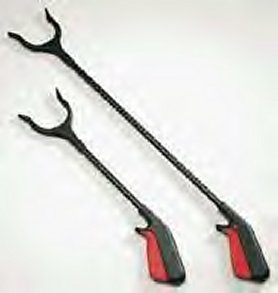
Description:
Device that allows users to pick up and move items without bending or reaching. Come in a variety of shapes and sizes.
Who should use it:
Individuals who have difficulty bending and reaching.
Return to Caring for Aging Parents


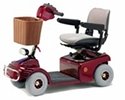



New! Comments
Have your say about what you just read! Leave me a comment in the box below.